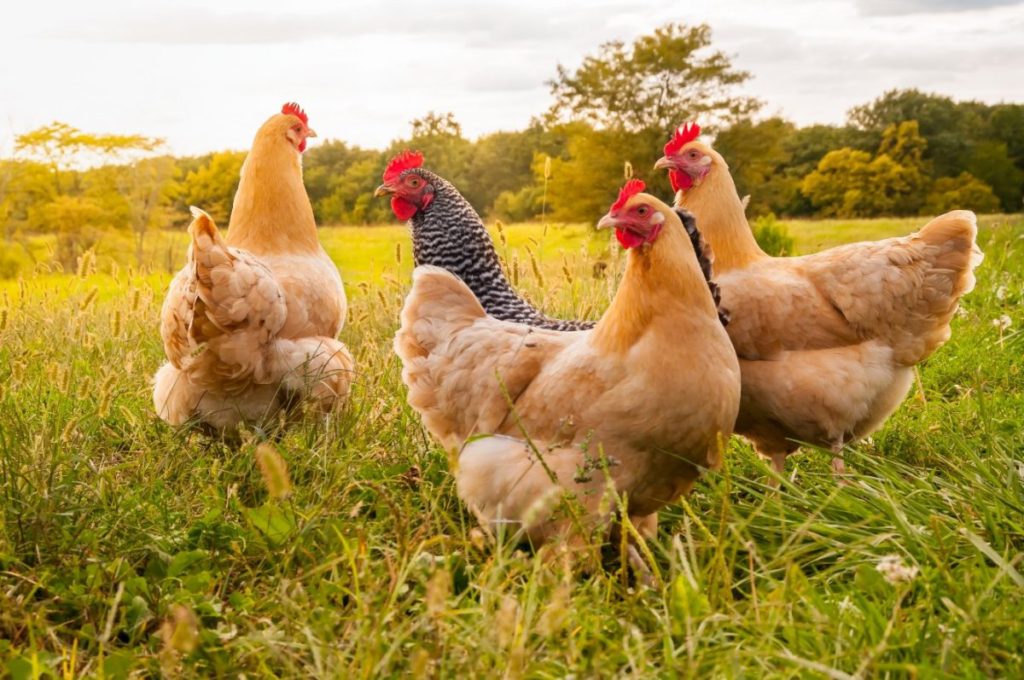Table of Contents
THE SKY IS FALLING!
There are many available versions of the story of Chicken Little, also known as Chicken Licken or Henny Penny. In all, the main character – irrationally believing that the sky is falling – convinces a lot of other animal characters to run for their lives. Classically, many of them end up eaten by a cagey fox (but not always).
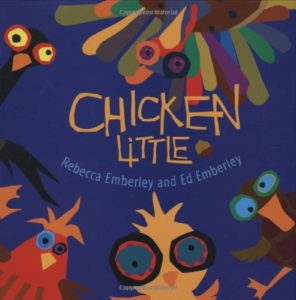
|
In Rebecca Emberley’s Chicken Little (Roaring Brook Press, 2009), the googly-eyed Chicken Little (“not the brightest chicken in the coop”) is bonked by an acorn, thinks the sky is falling, and leads a troop of equally silly friends into a “warm dark cave” – a fox’s mouth. A good bet for the tender-hearted, since it ends with a miraculous escape. For ages 3-7. |
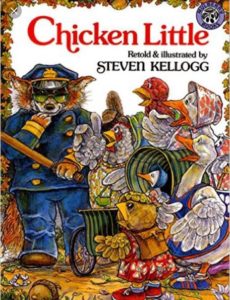 |
In Steven Kellogg’s Chicken Little (HarperCollins, 1987), the hysterical Chicken Little and friends are lured into a poultry van by a fox disguised as a policeman, with a last-minute save by a helicopter piloted by a hippopotamus. For ages 3-7. |
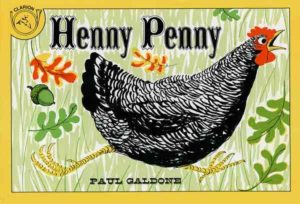
|
In Paul Galdone’s Henny Penny (Sandpiper, 1984), the main character is an excitable black-and-white hen who sets off with a gang of credulous friends to warn the king that the sky is falling. All end up as dinner for the fox. Be warned. For ages 4-8. |
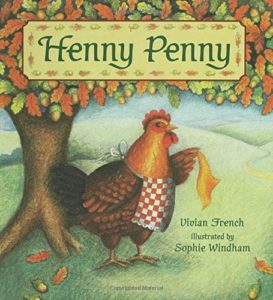
|
Vivian French’s Henny Penny (Bloomsbury USA, 2006) is more on the ball than most; once the fox has inveigled her and her friends into his den, Henny Penny – taking into account the chicken cookbook, bubbling stew pot, and some telltale bones and feathers – fools the fox and engineers a mass escape. For ages 4-8. |
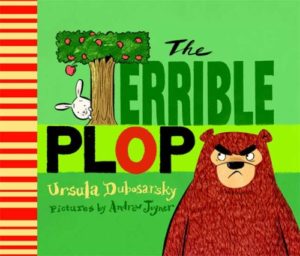
|
Ursula Dubosarsky’s rhyming picture book The Terrible Plop (Farrar, Straus & Giroux, 2009) is a chicken-less take on Chicken Little. Six rabbits, happily munching carrots and chocolate cake beside a lake, are terrified by a terrible PLOP. Five of them flee into the forest, picking up along the way a train of other scared animals, including a fox, monkey, pig, elephant, tiger, bat, and a big brown bear. The sixth stay-behind rabbit reveals the source of the terrible PLOP – it was an apple falling into the lake. For ages 3-7. |
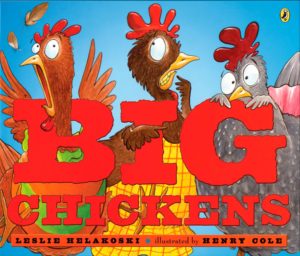
|
Leslie Helakoski’s Big Chickens (Puffin, 2008) are a nervous quartet of cowards. Frightened by a (quite pleasant-looking) wolf, they flee their coop, only to be terrified by a muddy ditch (bottomless pit?), a herd of cows, and a lake (icebergs?), until they end up in the wolf’s cave – where they inadvertently terrify the wolf. Sequels include Big Chickens Fly the Coop and Big Chickens Go to Town. For ages 3-7. |
| From the California Digital Library, check out this illustrated 19th-century edition of The Remarkable Story of Chicken Little. | |
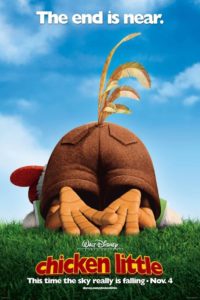 |
In the animated movie version of Chicken Little (Disney, 2005), Chicken Little and his band of misfit friends save the world from disaster (an alien invasion). |
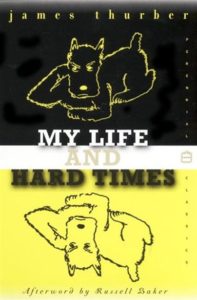
|
James Thurber’s wonderfully funny Chicken-Little story, “The Day the Dam Broke,” is found in My Life and Hard Times (Harper Modern Perennial Classics, 1999). During the 1913 Ohio flood, a rumor that the dam had broken swept the town of Columbus, resulting in a panic-stricken rout of hundreds of people, many of whom ended up climbing trees in Franklin Park, four miles out of town. The dam, needless to say, had not broken. For ages 12 and up. |
| Read “The Day the Dam Broke” online. |
CHICKEN-HEARTED?
| When did “chicken” come to mean “cowardly?” | |
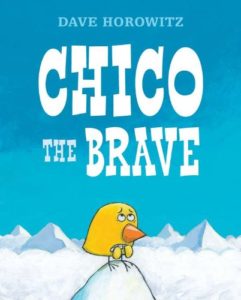
|
The hero of Dave Horowitz’s Chico the Brave (Nancy Paulsen Books, 2012) is an adorable, but cowardly, little yellow chick from the Andes Mountains. Attempting to calm Chico’s fears, which include a terror of his own shadow, his father invents the story of the fabulous Golden Chicken who – whenever someone is in trouble – swoops in to save the day. Chico sets off to find the Golden Chicken, ends up saving his flock from a gang of wicked llamas, and discovers that he’s braver than he thought he was. For ages 4-8. |
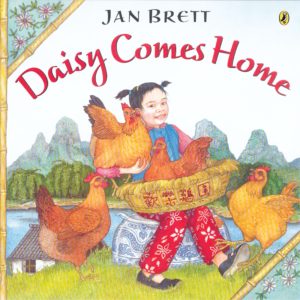
|
In Jan Brett’s exquisitely illustrated Daisy Comes Home (Puffin, 2005), set in China, Daisy is the smallest and unhappiest of Mei Mei’s six supposedly happy flock, picked on and teased by the larger hens. Miserable, she decides to spend the night in a basket by the side of the river – and is swept away into a series of adventures with a dog, a water buffalo, a gang of monkeys, and a fisherman. By the time Mei Mei rescues her and brings her back home, Daisy has become brave and self-confident, and is able to stand up to the rest of the flock. For ages 5-8. |
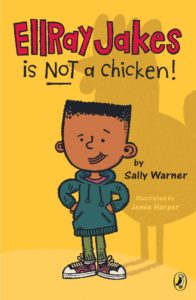
|
EllRay Jakes, the star of Sally Warner’s EllRay Jakes is Not a Chicken! (Puffin, 2012), is eight years old, the shortest person in the third grade, and the favorite victim of Jared Matthews, the class bully, and his sidekick Stanley. EllRay tries to understand Jared’s unprovoked attacks – it’s not, he determines, because he’s black (“Jared would have said something if it was. He is not the type of kid to keep things to himself.”); in fact, maybe it’s for no reason at all. Trouble escalates until EllRay’s father promises him a day at Disneyland if he can just keep out of trouble for one week – which looks iffy, until EllRay and Jared manage to solve their problems. This is the first of a series featuring EllRay, whose chatty first-person narration makes for a fun read. For ages 7-11. |
